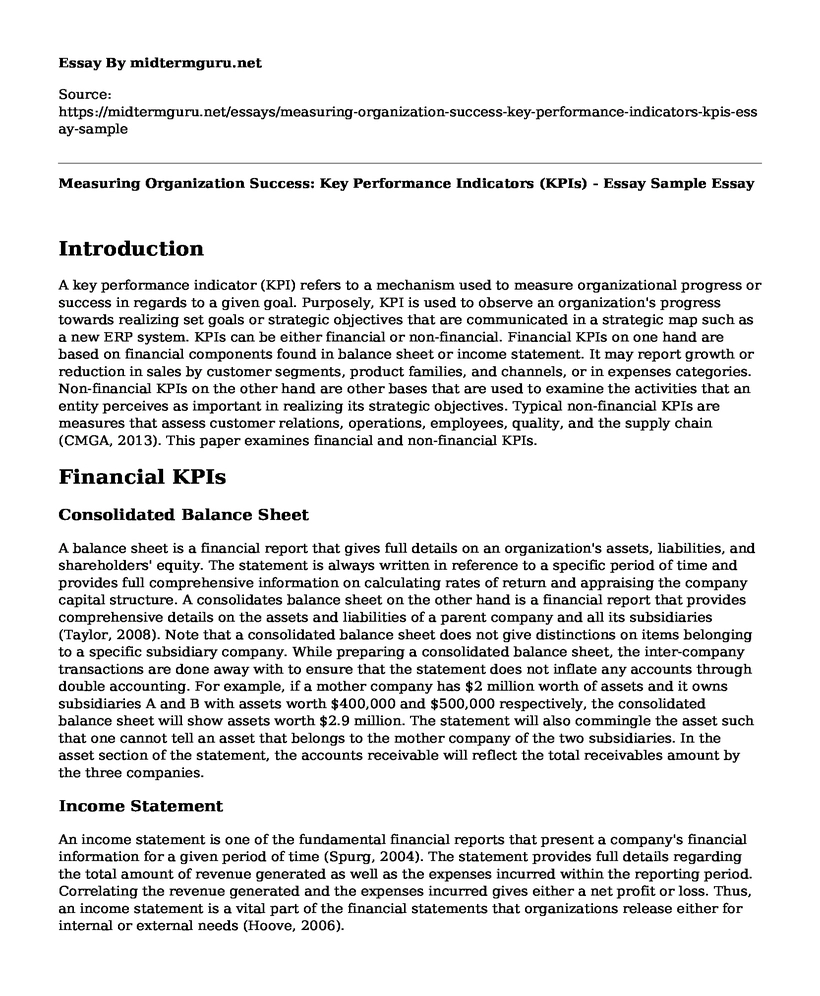Introduction
A key performance indicator (KPI) refers to a mechanism used to measure organizational progress or success in regards to a given goal. Purposely, KPI is used to observe an organization's progress towards realizing set goals or strategic objectives that are communicated in a strategic map such as a new ERP system. KPIs can be either financial or non-financial. Financial KPIs on one hand are based on financial components found in balance sheet or income statement. It may report growth or reduction in sales by customer segments, product families, and channels, or in expenses categories. Non-financial KPIs on the other hand are other bases that are used to examine the activities that an entity perceives as important in realizing its strategic objectives. Typical non-financial KPIs are measures that assess customer relations, operations, employees, quality, and the supply chain (CMGA, 2013). This paper examines financial and non-financial KPIs.
Financial KPIs
Consolidated Balance Sheet
A balance sheet is a financial report that gives full details on an organization's assets, liabilities, and shareholders' equity. The statement is always written in reference to a specific period of time and provides full comprehensive information on calculating rates of return and appraising the company capital structure. A consolidates balance sheet on the other hand is a financial report that provides comprehensive details on the assets and liabilities of a parent company and all its subsidiaries (Taylor, 2008). Note that a consolidated balance sheet does not give distinctions on items belonging to a specific subsidiary company. While preparing a consolidated balance sheet, the inter-company transactions are done away with to ensure that the statement does not inflate any accounts through double accounting. For example, if a mother company has $2 million worth of assets and it owns subsidiaries A and B with assets worth $400,000 and $500,000 respectively, the consolidated balance sheet will show assets worth $2.9 million. The statement will also commingle the asset such that one cannot tell an asset that belongs to the mother company of the two subsidiaries. In the asset section of the statement, the accounts receivable will reflect the total receivables amount by the three companies.
Income Statement
An income statement is one of the fundamental financial reports that present a company's financial information for a given period of time (Spurg, 2004). The statement provides full details regarding the total amount of revenue generated as well as the expenses incurred within the reporting period. Correlating the revenue generated and the expenses incurred gives either a net profit or loss. Thus, an income statement is a vital part of the financial statements that organizations release either for internal or external needs (Hoove, 2006).
Budget Control
Budgetary control refers to a process of preparing financial estimates for different activities and comparing the budgeted figures with actual expenses to identify deviations, which are done away with in future. Similarly, Brown and Howard defined budgetary control as a systematic coordination of costs that entails preparation of budgets, examining the responsibilities of individual departments, comparing the budgeted and actual expenses, and finally using the results to realize maximum profitability. It implies that while budgetary control is the final result and budgeting is the means (Taylor, 2008). Therefore, organizations use budgetary control as a continuous process that plays a critical role in planning and coordinating company operations. It is basically a control mechanism.
Non-Financial KPIs
Quality of Decision
Quality of decision refers to framework for assessing a good decision. Successful implementation of new system such as an ERP system depends on managers making and executing the right decision and in good time. Therefore, organizations need Decision Analysis (DA) criteria, which is a set of tools and concepts that expound on the clarity of the best alternative in a dynamic and uncertain environment. Managers need to go through DA to get the right choice (CMGA, 2013). To achieve this, they need to engage essential parties in decision making process to realize alignment and commitment to action. Therefore, quality of decision entails assessing the effectiveness of a decision. For a decision to be of high quality, it must meet six requirements, namely, taking the right frame, assessing alternative approaches, collecting all important data, clarifying values and tradeoffs, making use of logical reasoning, and commitment to chosen action.
Business Process Efficiency
In the contemporary business environment, most commercial organizations seek to realize agility in how they conduct businesses. In this quest, organizations are moving towards optimizing their business operations. Implementation of an ERP system is one of the examples. Similarly, numerous entities in the financial sector are investing highly in business robotics as part of process automation or artificial intelligence to streamline accounting services. Taking into consideration broader organizational process efficiency and measures of business helps financial departments in organizations to monitor return on investment (ROI), which also helps in better decision making (Thomas & James, 2006).
References
CMGA. (2013). Financial and Non-Financial KPI. Retrieved online on 22 May 2019 from: https://www.cgma.org/resources/tools/essential-tools/kpis.html
Hoove, M. R. (2006). Consolidated Financial Statements: An Alternative Perspective. South Africa: Paarl Print
Spurg, R. (2004). Balance Sheet Basics. New York, USA: Portfolio
Taylor, P. (2008). Consolidated Financial Reporting. Lancaster: Paul Chapman Publishing Ltd.
Thomas, G. & James, F. (2006). Understanding Balance Sheet. Harvard: City Publishers.
Cite this page
Measuring Organization Success: Key Performance Indicators (KPIs) - Essay Sample. (2023, Jan 12). Retrieved from https://midtermguru.com/essays/measuring-organization-success-key-performance-indicators-kpis-essay-sample
If you are the original author of this essay and no longer wish to have it published on the midtermguru.com website, please click below to request its removal:
- Essay Example on ERP and Changes
- Essay on Employee Motivation in Nursing
- Culture, Climate, and Ethics in a Company - Paper Example
- Paper Example on Leadership Qualities: Ida B. Wells Jr, and Martin Luther King
- Business Decision Making - Essay Sample
- Workplace Incivility: A Growing Challenge in Our Organization - Essay Sample
- Ab InBev: A Rich History of Mergers & Acquisitions - Essay Sample







